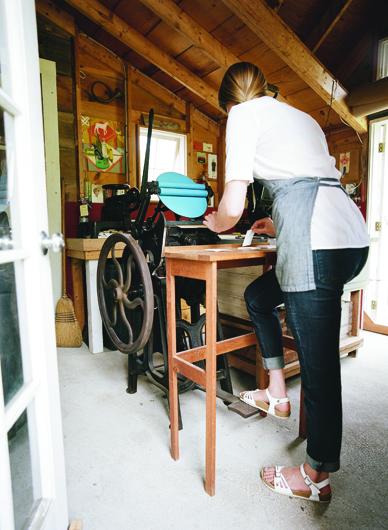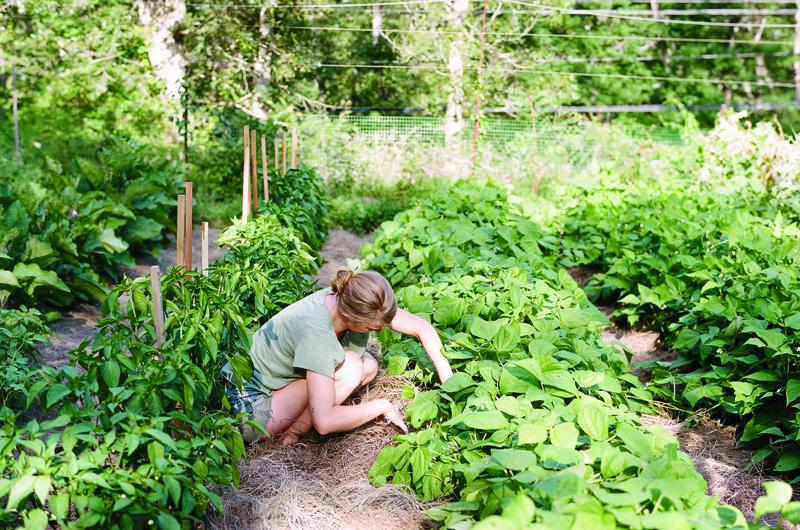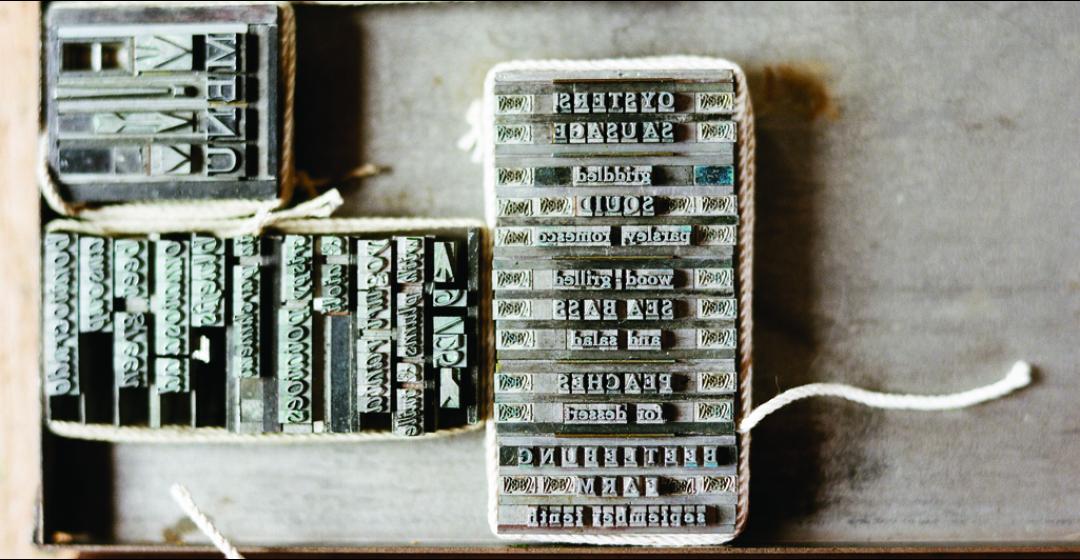When she talks about her late-nineteenth-century platen press, twenty-nine-year-old Emma Young calls it her “little baby.” She bought it on Craigslist the spring of 2011 and had recently outfitted it with new bolts, of which she was palpably proud. “It cost more than my car,” Young said, stroking its cool metal edges. “It’s my most prized possession.”
In letterpress printing, a platen refers to the flat metal plate that presses against a piece of paper to create an impression. Today most “letterpress” is done on a computer, but Young is committed to the look, feel, and process of working with a platen press.
In addition to the press, Young needed spacers, rulers, type, and ink to get her letterpress business running. In 2012 she found a collection of type in Portland, Maine, and got another large press from a Lambert’s Cove neighbor.
There has not been a lot of material written about the craft of platen presswork and Ralph W. Polk’s 1931 Elementary Platen Presswork remains the preeminent manual. In a section called “Process,” he wrote, “Instruction in this field has been rather unorganized, and often
fragmentary. The need for a book to cover the details of elementary presswork has been keenly felt in the schools and shops in which boys are being trained, and it is in response to that need that this book has been written.”

Sometimes in her studio Young imagines herself as one of those printers in a striped shirt and ink-covered white apron. Largely self-taught, she relates to Polk’s fragmentary instruction. Young took a book arts course with a letterpress component when she was a student at Hampshire College, in Amherst, Massachusetts. But learning to use the old-fashioned tools that she has a penchant for was an entirely new undertaking.
Young’s studio is a repurposed animal stall on Cackleberry Farm, her parents’ property off Lambert’s Cove in West Tisbury. When you enter her artistic domain you might meet Bebe, the energetic mutt who looks like a miniature black lab, or Tea Cup, the lazy orange barn cat. Honeybees buzz and hover over two hives in front of the studio. Across a field of greens is the home her parents, Scott and Terre, built in 1984 where she and her brother, Mac, grew up.
Scott Young does restoration construction and has a knack for homesteading. The evolution of his land into a small but productive farm has been ten years in the making. His specialty is garlic, of which he grows several varieties. Cackleberry Farm also produces lettuce, tomatoes, peppers, eggplant, onions, squash, herbs, and eggs (“cackleberry” is 1950s diner slang for an egg). There are also fruit trees and honeybee hives, and in the past the Youngs have kept goats and sheep, but now that pastureland is dedicated to growing veggies.
Since she moved back to the Vineyard five years ago, Young has taken over marketing her dad’s produce and selling it to local restaurants. The father-daughter duo has an easy working relationship. He farms for the joy of it, learning about different plants as he goes. Young makes sure everything is ready for market at the right time, not letting anything slip by. “I like seeing our work go out into the world,” she said.
In her studio in the early weeks of summer, Young is wearing vintage Levi’s jeans and a grey tank top. A friend once told her that she dresses like the ocean, always in shades of blue and beige. With her long, wispy blonde hair and clear blue eyes, the comparison is not a stretch. “I’ve always been conservative with color,” she agreed. But her garden blooms just a few feet from the studio and Young thinks that proximity has made her more liberal with the color palette. “I’ve always worked in tandem with plants and words,” she said, gesturing toward her letterpress equipment and gardens in one fluid motion. “I benefit so much from this farm.”

“Words, books, plants, and growing.” These are Young’s most favorite things, she said, and having her studio right on the farm has allowed her to do both.
Considering the ease and speed of digital design, it’s hard to comprehend the amount of time and labor Young puts into her work. “I can only do what my tools are capable of,” she said, “and that’s not for everyone.” In the early summer, on the very day that Young printed an invitation package for a fall wedding, the bride changed her mind about the ceremony site and the invitations had to be redone. “That would be no big deal for someone working on a computer, but for me – I have to start over.”
And yet her work is so strikingly simple and beautiful, with delicate details – teeny lavender flowers in this particular case – that it’s not hard to see why she is steadily busy.
Young tries to do as much paid work in the summer as she can handle, which allows her the time to do more creative, personal work in the winter. This past spring she was named West Tisbury’s poet laureate, and recently wrote, printed, and published a collection of poetry called Tomato Skin Diamond. She also did the print work for Island chef Chris Fischer’s The Beetlebung Farm Cookbook, which was published in June.
Sarah Soushek of Oak Bluffs heard about Young’s work through a friend. She already had a vintage vibe in mind for her September wedding and when she and her fiancé, Colin, went to visit Young at her studio, she knew immediately their styles were compatible. “Emma has such an artistic eye, but she keeps it within the parameters of her nineteenth-century equipment,” Soushek said.

For instance, when Soushek was debating whether to include a wedding website on the invite, Young pointed out that a URL would conflict with the nature of the art form. Soushek ultimately agreed.
Sense of place is central to Young’s identity, and although she worked in New York City last winter, she has no doubts about where her home is. “So much of my world is here,” she said. She doesn’t advertise her letterpress work much and trusts that the people who are meant to will find her. “People who find me, find me through this community,” she said. “I’m centered in this place.”
Recently, Young has been emerging from her studio in the early evening for cocktail hour with a friend at the nearby barn where she lives. They have been making herbal beer from wild plants foraged on and around Cackleberry Farm. Looking contentedly far away from her old Upper West Side apartment, Young was anticipating that evening’s beer.
“That kind of cocktail hour feels really right,” she said.




 1 comment
1 comment
Comments (1)